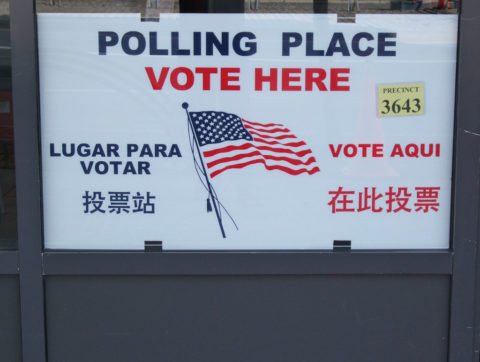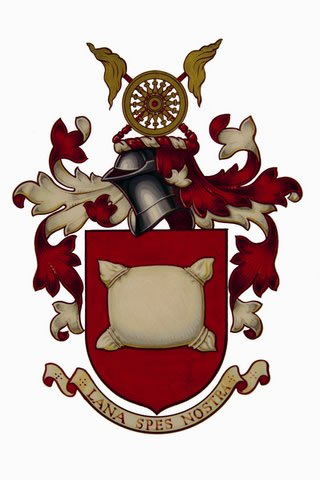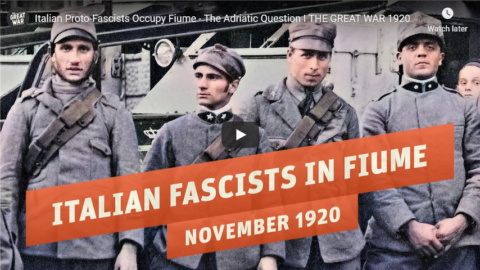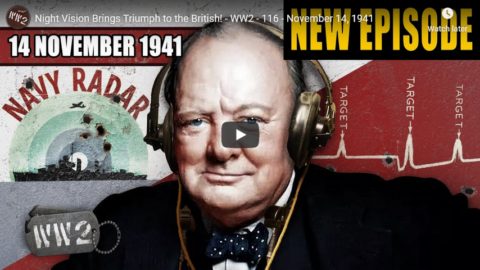The Great War
Published 14 Nov 2020Sign up for Curiosity Stream for 40% OFF and get Nebula bundled in: https://curiositystream.com/thegreatwar
Italy was promised a lot of territorial gains for entering the First World War on the Allied side. But in 1919, the map of Europe had changed and the Allies were less interested in only fulfilling Italian territorial ambitions. Push came to shove when Italian Fascists around nationalist Gabriele D’Annunzio occupied the coastal city of Fiume in the newly created Yugoslavia.
» SUPPORT THE CHANNEL
Patreon: https://www.patreon.com/thegreatwar» OUR PODCAST
https://realtimehistory.net/podcast – interviews with World War 1 historians and background info for the show.» BUY OUR SOURCES IN OUR AMAZON STORES
https://realtimehistory.net/amazon *
*Buying via this link supports The Great War (Affiliate-Link)» SOURCES
Albrecht-Carrié, René, Italy at the Paris Peace Conference, (Hamden, CT: Archon Books, 1966)Burgwyn, H. James, Italian Foreign Policy in the Interwar Period, 1918-1940, (Westport, CT: Praeger, 1997)
Cattaruzza, Marina, “The Making and Remaking of a Boundary – the Redrafting of the Eastern Border of Italy after the two World Wars”, Journal of Modern European History, Vol. 9, No. 1, Space, Borders, Maps (2011)
Kitchen, Martin, Europe Between the Wars: A Political History, (Harlow: Longman Group, 1988)
Lederer, Ivo J., Yugoslavia at the Paris Peace Conference: A Study in Frontiermaking, (New Haven, CT: Yale University Press, 1963)
Bozanich, Stevan, “Post-war Turmoil and Violence (Yugoslavia)”, in: 1914-1918-online. International Encyclopedia of the First World War, ed. by Ute Daniel, Peter Gatrell, Oliver Janz, Heather Jones, Jennifer Keene, Alan Kramer, and Bill Nasson, issued by Freie Universität Berlin, Berlin 2019-11-20.
Innerhofer, Ian, “Post-war Societies (South East Europe)”, in: 1914-1918-online. International Encyclopedia of the First World War, ed. by Ute Daniel, Peter Gatrell, Oliver Janz, Heather Jones, Jennifer Keene, Alan Kramer, and Bill Nasson, issued by Freie Universität Berlin, Berlin 2014-10-08.
Baravelli, Andrea, “Post-war Societies (Italy)”, in: 1914-1918-online. International Encyclopedia of the First World War, ed. by Ute Daniel, Peter Gatrell, Oliver Janz, Heather Jones, Jennifer Keene, Alan Kramer, and Bill Nasson, issued by Freie Universität Berlin, Berlin 2015-09-03.
Lynn Williams’ (Pluto Press, 1975)
Hans Ulrich, “I redentori della vittoria: On Fiume’s Place in the Genealogy of Fascism”, Journal of Contemporary History Vol. 31, No. 2, Special Issue: The Aesthetics of Fascism (Apr., 1996))
» MORE THE GREAT WAR
Website: https://realtimehistory.net
Instagram: https://instagram.com/the_great_war
Twitter: https://twitter.com/WW1_Series
Reddit: https://reddit.com/r/TheGreatWarChannel»CREDITS
Presented by: Jesse Alexander
Written by: Jesse Alexander
Director: Toni Steller & Florian Wittig
Director of Photography: Toni Steller
Sound: Toni Steller
Editing: Toni Steller
Motion Design: Philipp Appelt
Mixing, Mastering & Sound Design: http://above-zero.com
Maps: Daniel Kogosov (https://www.patreon.com/Zalezsky)
Research by: Jesse Alexander
Fact checking: Florian WittigChannel Design: Alexander Clark
Original Logo: David van StepholdContains licensed video and photos by getty images
Icons made by Freepik from www.flaticon.com
All rights reserved – Real Time History GmbH 2020
November 15, 2020
Italian Proto-Fascists Occupy Fiume – The Adriatic Question I THE GREAT WAR 1920
Mark Steyn is looking for an argument
I somehow missed this when it went up on Mark’s website:

“Polling Place Vote Here” by Scott Beale is licensed under CC BY-NC-ND 2.0
One of Mrs Thatcher’s great insights was: First you win the argument; then you win the election.
To win the argument, you have to make it. In the Westminster system, you make the argument for three or four years, then you have a six-week election campaign. That’s when the system’s functioning, which it certainly wasn’t under, say, Andrew Scheer’s Tory leadership in Ottawa.
But, even when it’s not functioning, somebody’s making an argument. Thus the fatal miscalculation of David Cameron when he decided that the Brexit referendum would be the best way to put the EU issue to bed once and for all. By then every electorally viable political party — from the Tories to Sinn Féin — was “pro-Europe”. Nigel Farage had been making the argument for twenty years, but, because he had no real political party to advance it, it didn’t get him anywhere at UK general elections. So, the minute Cameron called a referendum on Nigel’s issue in splendid isolation, it gave Farage a shot at the second half of Maggie’s great formulation: He’d won the argument; and Cameron delivered up a mechanism that allowed him to win the vote.
In the American system, it is, as the Brits say, arse over tit: As Monty Python once asked, where’s the room for an argument? There are no parliamentary debates, so you never see a Dem senator going at it with a GOP senator. Even more strikingly, there are a bazillion political talk shows, none of which ever features a Dem senator going at it with a GOP senator — the way that even the most despised BBC, CBC, ABC yakfests routinely feature opposing legislators debating health care or the Irish backstop or Covid response.
Instead, there is a multi-billion-dollar two-year campaign, which is all polls, fundraising, horse race piffle, telly ads for the halfwitted, plot twists of no interest to anybody normal (ooh, look, Cory Booker is up from point-three to point-four in Iowa!), all culminating in a stilted pseudo-debate tediously moderated by a pompous mediocrity asking questions all framed from the left’s point of view. You’d almost get the idea that the entire racket was designed to eliminate the very possibility that someone might make an argument.
London’s wool and cloth trade fuelled massive growth in the city’s population after 1550
In the latest Age of Invention newsletter, Anton Howes traces the rise and fall of the late Medieval wool trade and its rebirth largely thanks to an influx of Dutch and Flemish clothmakers fleeing the wars in the Low Countries after 1550:

The Coat of Arms of The Worshipful Company of Woolmen — On a red background, a silver woolpack, with the addition of a crest on a wreath of red and silver bearing two gold flaxed distaffs crossed like a saltire and the wheel of a gold spinning wheel.
The Worshipful Company of Woolmen is one of the Livery Companies in the City of London. It is known to have existed in 1180, making it one of the older Livery Companies of the City. It was officially incorporated in 1522. The Company’s original members were concerned with the winding and selling of wool; presently, a connection is retained by the Company’s support of the wool industry. However, the Company is now primarily a charitable institution.
The Company ranks forty-third in the order of precedence of the Livery Companies. Its motto is Lana Spes Nostra, Latin for Wool Is Our Hope.
Wikipedia.
… it was one thing to be able to reach these new southern markets, and another thing to have something to sell in them. For the shift in the markets for wool cloth exports also required major changes in the kinds of cloth produced. In this regard, London may well have been a direct beneficiary of the 1560s-80s troubles in the Low Countries that had caused Antwerp’s fall, because thousands of skilled Flemish and Dutch clothmakers fled to England. In particular, these refugees brought with them techniques for making much lighter cloths than those generally produced by the English — the so-called “new draperies”, which could find a ready market in the much warmer Mediterranean climes than the traditional, heavy woollen broadcloths.
The introduction of the new draperies was no mere change in style, however. They were almost a completely different kind of product, involving different processes and raw materials. The traditional broadcloths were “woollens”. That is, they were made from especially fine, short, and curly wool fibres — the type that English sheep were especially famous for growing — which were then heavily greased in butter or oil in preparation for carding, whereby the fibres were straightened out and any knots removed (because of all the oil, in the Low Countries the cloths were known as the wet, or greased draperies). The oily, carded wool was then spun into yarn, and typically woven into a broad cloth about four metres wide and over thirty metres long. But it was still far from ready. The cloth had to be put in a large vat of warm water, along with some urine and a particular kind of clay, and was then trodden by foot for a few days, or else repeatedly compacted by water-powered machinery. This process, known as fulling, scoured the cloth of all the grease and shrunk it, compacting the fibres so that they began to interlock and enmesh. Any sign of the cloth being woven thus disappeared, leaving a strong, heavy, and felt-like material that was, as one textile historian puts it, “virtually indestructible”. To finish, it was then stretched with hooks on a frame, to remove any wrinkles and even it out, and then pricked with teasels — napped — to raise any loose fibres, which were then shorn off to leave it with a soft, smooth, sometimes almost silky texture. Woollens may have been made of wool, but they were no woolly jumpers. They were the sort of cloth you might use today to make a thick, heavy and luxuriant jacket, which would last for generations.
Yet this was not the sort of cloth that would sell in the much warmer south. The new draperies, introduced to England by the Flemish and Dutch clothworkers in the mid-sixteenth century, used much lower-quality, coarser, and longer wool. Later generally classed as “worsteds”, after the village of Worstead in Norfolk, they were known in the Low Countries as the dry, or light draperies. They needed no oil, and the long fibres could be combed rather than carded. Nor did they need any fulling, tentering, napping, or shearing. Once woven, the cloth was already strong enough that it could immediately be used. The end product was coarser, and much more prone to wear and tear, but it was also much lighter — just a quarter the weight of a high-quality woollen. And the fact that the weave was still visible provided an avenue for design, with beautiful diamond, lozenge, and other kinds of patterns. The new draperies, which included worsteds and various kinds of slightly heavier worsted-woollen hybrids, as well as mixes with other kinds of fibre like silk, linen, Syrian cotton, or goat hair, thus came in a dazzling number of varieties and names: from tammies or stammets, to rasses, bays, says, stuffs, grograms, hounscots, serges, mockadoes, camlets, buffins, shalloons, sagathies, frisadoes, and bombazines. To escape the charge that the new draperies were too flimsy and would not last, some varieties were even marketed as durances, or perpetuanas.
Curiously, however, while the shift from woollens to worsted saved on the costs of oiling, fulling, and finishing, it was significantly more labour-intensive when it came to spinning — even resulting in a sort of technological reversion. Given the lack of fulling, the strength of the thread mattered a lot more for the cloth’s durability, and the yarn had to be much finer if the cloth was to be light. The spinning thus had to be done with much greater care, which made it slower. Spinners typically gave up using spinning wheels, instead reverting to the old method of using a rock and distaff — a technique that has been used since time immemorial. Albeit slower, the rock and distaff gave them more control over the consistency and strength of the ever-thinner yarn. For the old, woollen drapery, processing a pack of wool into cloth in a week would employ an estimated 35 spinners. For the new, lighter worsted drapery it would take 250. As spinning was almost exclusively done by women, the new draperies provided a massive new source of income for households, as well as allowing many spinsters or widows to support themselves on their own. Indeed, an estimated 75% of all women over the age of 14 might have been employed in spinning to produce the amounts of cloth that England exported and consumed. Some historians even speculate that by allowing women to support themselves without marrying, it may have lowered the national fertility rate.
This spinning, of course, was not done in London. It was largely concentrated in Norfolk, Devon, and the West Riding of Yorkshire. But the new draperies provided employment of another, indirect kind. As a product that was saleable in warmer climes it could be exchanged for direct imports of all sorts of different luxuries, from Moroccan sugar, to Greek currants, American tobacco (imported via Spain), and Asian silks and spices (initially largely imported via the eastern Mediterranean). The English merchants who worked these luxury import trades were overwhelmingly based in London, and had often funded the voyages of exploration and embassies to establish the trades in the first place, putting them in a position to obtain monopoly privileges from the Crown so that they could restrict domestic competition and protect their profits. Unsurprisingly, as they imported everything to London, it also made sense for them to export the new draperies from London too.
Thus, despite losing the concentrating influence of nearby Antwerp, London came to be the principal beneficiary of England’s new and growing import trades, allowing it to grow still further. The city began to carve out a role for itself as Europe’s entrepôt, replacing Antwerp, and competing with Amsterdam, as the place in which all the world’s rarities could be bought (and from which they could increasingly be re-exported). Indeed, English merchants were apparently happy to sell wool cloth at below cost-price in markets like Spain or Turkey — anything to buy the luxury wares that they could monopolise back home.
Michael Symon’s Essential Knives You Need to Own | Food Network
Food Network
Published 13 Aug 2020Take it from the pro Michael Symon: These are *THE* essential knives you need to make your meal prep quick and efficient! 🔪🔪
Have you downloaded the new Food Network Kitchen app yet? With up to 25 interactive LIVE classes every week and over 80,000 recipes from your favorite chefs, it’s a kitchen game-changer. Download it today: http://food-network.app.link/download!
#SymonDinners, Sundays at 12:30|11:30c.
Follow Food Network on Instagram: https://www.instagram.com/foodnetwork/
Follow Food Network on Twitter: https://twitter.com/FoodNetwork
Visit Food Network online: http://www.foodnetwork.com
QotD: Early successes in recruit training
Still, we are getting on. Number Three Platoon (which boasts a subaltern) has just marched right round the barrack square, without —
(1) Marching though another platoon.
(2) Losing any part or parts of itself.
(3) Adopting a formation which brings it face to face with a blank wall, or piles it up in a tidal wave upon the verandah of the married quarters.
They could not have done that a week ago.
Ian Hay (Major John Hay Beith), The First Hundred Thousand: Being the Unofficial Chronicle of a Unit of “K(1)”, 1916.






